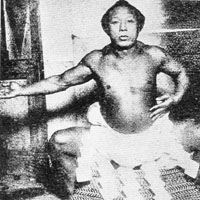Loading AI tools
Japanese sumo wrestler From Wikipedia, the free encyclopedia
Ōnishiki Daigorō (Japanese: 大錦 大五郎, 1883 – 18 May 1943) was a Japanese professional sumo wrestler. He was the sport's 28th yokozuna.
| Ōnishiki Daigorō | |
|---|---|
| 大錦 大五郎 | |
 | |
| Personal information | |
| Born | Yamada Daigorō 1883 Aichi, Japan |
| Died | 18 May 1943 (aged 60) |
| Height | 1.76 m (5 ft 9+1⁄2 in) |
| Weight | 112 kg (247 lb) |
| Career | |
| Stable | Asahiyama |
| Record | 162-50-74 14draws-10holds (Makuuchi in Osaka) |
| Debut | November 1898 |
| Highest rank | Yokozuna (April 1918) |
| Retired | January 1922 |
| Championships | 6 (Osaka Makuuchi, unofficial) |
| * Up to date as of October 2007. | |
He was born Yamato Daigorō (山田 大五郎) in Ama District, Aichi Prefecture, in what is now Yatomi City. There are several conflicting sources as to his specific birth date in 1883, and he later changed his surname to Torii (鳥井)
He started sumo in Kyoto in 1898, later moving to Osaka. He entered the top makuuchi division in February 1906. He was promoted to ōzeki in June 1910. In April 1918 he became the 28th yokozuna (the third in Osaka sumo). The reason for his promotion to yokozuna was cited as being because of his great dignity.[1] He fought in eight tournaments as yokozuna, retiring after the January 1922 basho.
After retirement he ran a tea house in Osaka.
Some of his memorabilia is on display in a museum in Yatomi City.
| First | Second | |||||
|---|---|---|---|---|---|---|
| 1906 | East Maegashira #8 5–2–1 1d 1h |
East Maegashira #5 4–1–5 |
||||
| 1907 | West Maegashira #1 5–2–1 2h |
West Komusubi 6–3–1 |
||||
| 1908 | West Sekiwake 6–3–1 |
West Sekiwake 8–1–1 |
||||
| 1909 | West Sekiwake 5–3–2 |
West Sekiwake 7–1–2 |
||||
| 1910 | West Sekiwake 3–2–3 1d 1h |
West Ōzeki 5–3–1 1d |
||||
| 1911 | West Ōzeki 2–3–4 1d |
West Ōzeki 8–1–1 Unofficial |
||||
| 1912 | West Ōzeki 7–1–1 1d |
Not held | ||||
| 1913 | West Ōzeki 7–2–1 |
West Ōzeki 7–2–1 Unofficial |
||||
| 1914 | West Ōzeki 6–1–3 |
West Ōzeki 8–0–1 1d Unofficial |
||||
| 1915 | East Ōzeki 6–2–2 |
East Ōzeki 8–0–2 Unofficial |
||||
| 1916 | East Ōzeki 5–2–2 1h |
Not held | ||||
| 1917 | East Ōzeki 8–0 2h Unofficial |
East Ōzeki 7–1 1d 1h |
||||
| 1918 | West Ōzeki 8–1 1h Unofficial |
East Yokozuna 2–4–3 1d |
||||
| 1919 | West Yokozuna 1–1–8 |
West Yokozuna 6–2 2d |
||||
| 1920 | West Yokozuna 1–1–8 |
East Yokozuna 4–3 2d 1h |
||||
| 1921 | Sat out | East Yokozuna 4–0–5 1d |
||||
| 1922 | West Yokozuna 3–2–4 1d |
Retired – |
||||
| Record given as win-loss-absent Top Division Champion Top Division Runner-up Retired Lower Divisions Key:d=Draw(s) (引分); h=Hold(s) (預り) | ||||||
*Championships for the best record in a tournament were not recognised or awarded in Osaka sumo before its merger with Tokyo sumo, and the unofficial championships above are historically conferred. For more information, see yūshō.
Seamless Wikipedia browsing. On steroids.
Every time you click a link to Wikipedia, Wiktionary or Wikiquote in your browser's search results, it will show the modern Wikiwand interface.
Wikiwand extension is a five stars, simple, with minimum permission required to keep your browsing private, safe and transparent.